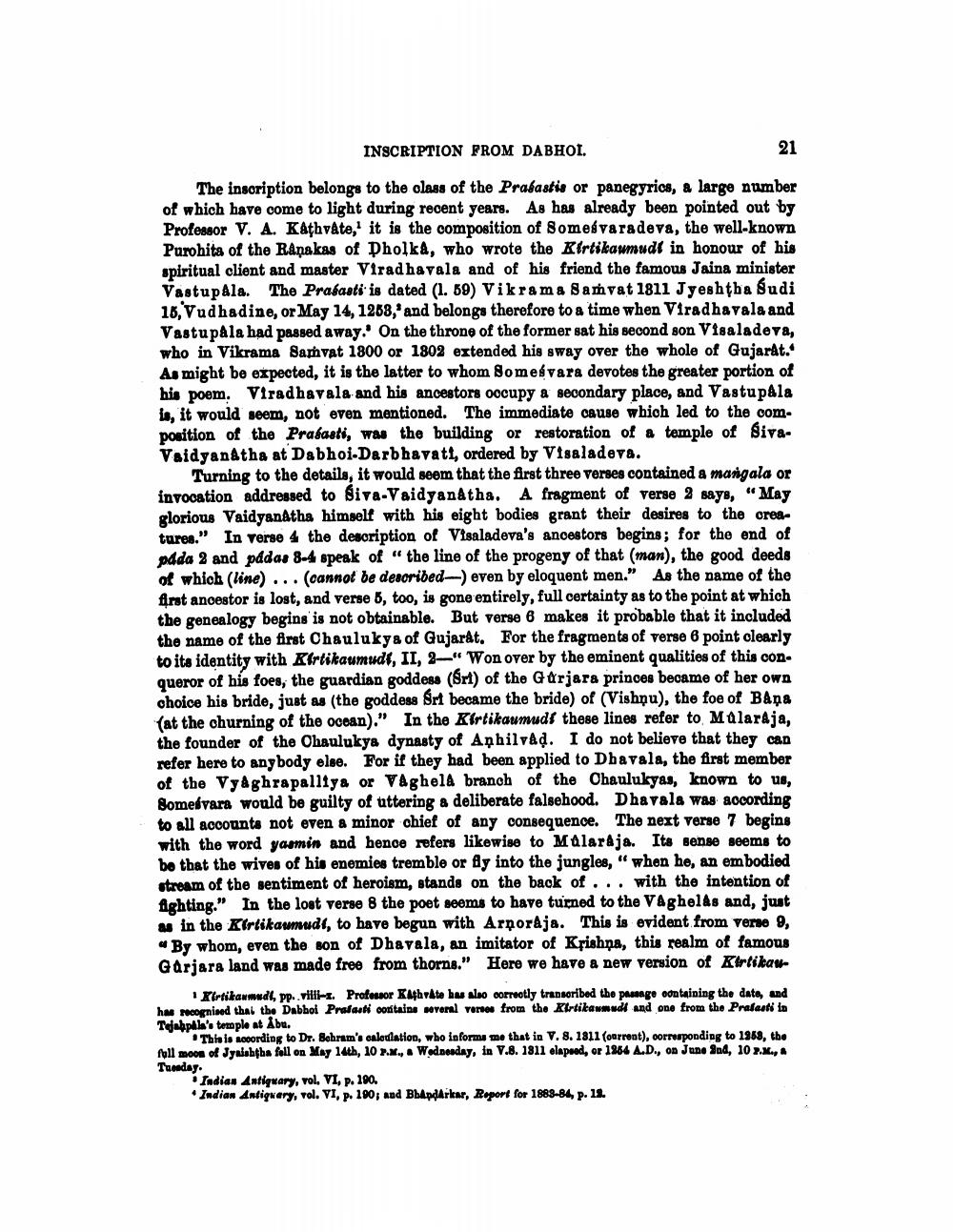________________
INSCRIPTION FROM DABHOL.
The inscription belongs to the class of the Prabastio or panegyrics, a large number of which have come to light during recent years. As has already been pointed out by Professor V. A. Kathvate, it is the composition of domesvaradeva, the well-known Purohita of the Ranakas of Dholka, who wrote the Kirtikaumudi in honour of his spiritual client and master Virad havala and of his friend the famous Jaina minister Vastupala. The Prasasti' is dated (1. 59) Vikrama Saṁvat 1811 Jyeshțba Sudi 16, Vudhadine, or May 14, 1268,' and belongs therefore to a time when Viradhavala and Vastupala had passed away. On the throne of the former sat his second son Visaladeva, who in Vikrama Samvat 1800 or 1802 extended his sway over the whole of Gujarat. As might be expected, it is the latter to whom some vara devotes the greater portion of his poem. Viradhavala and his ancestors oocupy a secondary place, and Vastupala is, it would seem, not even mentioned. The immediate cause which led to the composition of the Prasasti, was the building or restoration of a temple of SivaVaidyanatha at Dabhoi-Darbhavati, ordered by Visaladeva.
Turning to the details, it would seem that the first three verses contained a mangala or invocation addressed to Siva-Vaidyanatha. A. fragment of verse 2 says, “May glorious Vaidyanatha himself with his eight bodies grant their desires to the creatures." In verse 4 the description of Visaladeva's ancestors begins; for the end of pdda 2 and pádas 8-4 speak of "the line of the progeny of that (man), the good deeds of which (line) ... (cannot be described-) even by eloquent men." As the name of the first anoestor is lost, and verse 8, too, is gone entirely, full certainty as to the point at which the genealogy begins is not obtainable. But verse 6 makes it probable that it included the name of the first Chaulukya of Gujarat. For the fragments of verse 6 point clearly to its identity with Kfrtikaumudi, II, 24" Won over by the eminent qualities of this conqueror of his foes, the guardian goddess (Srt) of the Garjera princes became of her own choice his bride, just as the goddess Srt became the bride) of (Vishnu), the foe of Bana (at the churning of the ocean)." In the Kirtikaumudi these lines refer to Malaraja, the founder of the Ohaulukya dynasty of Anhilvad. I do not believe that they can refer here to anybody else. For if they had been applied to Dhavala, the first member of the Vyaghrapalliys or Vaghela branch of the Chaulukyas, known to us, Somebyara would be guilty of uttering & deliberate falsehood. Dhavala was according to all accounts not even a minor chief of any consequence. The next verse 7 begins with the word yasmin and hence refers likewise to Malaraja. Its sense seems to bo that the wives of his enemies tremble or fly into the jungles, " when he, an embodied stream of the sentiment of heroism, stands on the back of ... with the intention of Achting." In the lost verse 8 the poet seems to have turned to the Vaghelas and, just w in the Kirtikaumudi, to have begun with Arnoraja. This is evident from verse 9, "By whom, even the son of Dhavala, an imitator of Krishna, this realm of famous Gariara land was made free from thorns." Here we have a new version of Kirtidas
Kirtikawmadh, pp..vil-E. Professor Kihvate hus sloo correotly transcribed the parengo containing the date and hu Moognised that the Dabhol Praiat contains several remes from the Kirtikanmud and one from the Prala la Tejahpella't temple at Abu.
This is nooording to Dr. Behram'ı calocation, who informa me that in V. 8. 1311 (current), corresponding to 1363, the full moon of Jyniobtha fall on May 14th, 10 .M., Wednesday, in V.8. 1811 lapoed, or 1864 A.D., on June 2nd, 10 2.M., Tuesday.
Indian Antiquary, vol. VI, p. 190. • Indian Antiquary, rol. VI, p. 190; and Bhandarkar, Report for 1888-84, p. 18.




